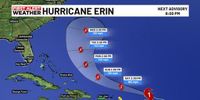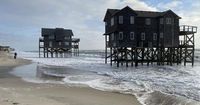Hurricane Erin, the first hurricane of the 2025 Atlantic season, has rapidly intensified over the past several days, prompting widespread concern across the Caribbean and the U.S. East Coast. As the storm churns through the Atlantic, meteorologists and coastal residents alike are keeping a close eye on its path, strength, and the potential hazards it poses—not just from wind and rain, but from powerful waves and dangerous rip currents that could threaten lives and property hundreds of miles from the storm’s center.
According to the National Hurricane Center (NHC), Erin became a Category 1 hurricane on Friday, August 15, 2025, with maximum sustained winds of 75 mph. At 2 p.m. that day, the storm was located about 415 miles east of the northern Leeward Islands, moving west-northwest—a trajectory expected to continue through the weekend. Tropical storm watches were promptly issued for several islands in the Northern Leewards, including St. Martin, St. Barts, Anguilla, and Barbuda. Residents there prepared for up to 6 inches of rain between Friday and Saturday, along with gusty winds and the risk of flash flooding and mudslides, as reported by ABC News.
As Erin advanced, forecasts indicated a rapid intensification. The NHC projected that Erin could become a major hurricane—Category 3 or higher—by Sunday morning, August 17, with winds potentially reaching 125 mph. By late Friday, meteorologists warned that Erin might even escalate to Category 4 status, with maximum sustained winds climbing to 140 mph or more by Monday, August 18, according to WWSB in Sarasota. Some models suggested peak winds could approach 145 mph, underscoring the storm’s potential for significant power.
Despite these alarming numbers, most forecast models showed a strong consensus: Erin would remain well offshore, tracking north early next week and staying far from the Florida and Bermuda coastlines. "Confidence in Erin’s forecast path is notably high," WWSB noted, referencing both global and regional model agreement. This consensus was echoed by the NHC, which stated, "While the threat of direct impacts in the Bahamas and along the east coast of the United States appears to be gradually decreasing, there will still be a significant risk of dangerous surf and rip currents along western Atlantic beaches next week."
For Florida, this was welcome news. No watches or warnings were in effect for the state as of August 15, and the East Coast was expected to escape rain and wind threats from Erin. However, rough surf and elevated rip currents were anticipated to begin early-to-mid next week, especially along Atlantic beaches. The Suncoast (West Coast Florida) faced no direct impacts from Erin, only the typical afternoon sea breeze storms and continued hot, humid conditions—a heat advisory was likely for Saturday, with temperatures in the mid-90s and heat index values exceeding 107°F, as detailed by WWSB.
Farther north, the situation was more precarious for the Outer Banks of North Carolina. Large waves—between 8 to 12 feet—were expected to batter the coastline between August 20 and August 27, raising alarms for erosion and property damage. According to The News & Observer, two oceanfront homes in Rodanthe were "very, very vulnerable" to collapse, exposed to pounding surf that has already claimed more than a dozen homes in the area since 2020. Mark Gray of WM Dunn Construction described the situation bluntly: “Two houses for sure are on the verge of collapse.” Cape Hatteras National Seashore Superintendent Dave Hallac added, “If there’s very strong waves smacking into the pilings, it’s going to increase the probability of a problem.” These homes, though currently unoccupied, remain at risk of falling into the ocean, potentially scattering debris along miles of shoreline—a scenario that has played out repeatedly in recent years.
Beach erosion and home collapses have become a focal point in the Outer Banks, where rising sea levels and stronger storms are reshaping the coastline. In some cases, property owners have moved homes farther inland or opted for controlled demolitions to limit debris. But as Erin’s powerful swell approaches, officials and residents are left with little to do but watch and hope for the best. Hallac summed up the mood: “We’ll hope all of the structures are able to survive the waves that come through. For now, it’s just wait and see.”
Elsewhere along the East Coast, the risk from Erin is less about direct wind or rain and more about what’s happening offshore. The NHC and local meteorologists warned that dangerous rip currents and large waves could threaten swimmers and surfers from the Carolinas up to Virginia and beyond. Some areas of South Carolina and Virginia could see waves reaching 6 feet. Even though king tides—the seasonal high tides that often worsen erosion—are not expected during Erin’s closest approach, the storm’s wave action alone is enough to pose a threat to unstable properties and public safety.
For Puerto Rico and the U.S. Virgin Islands, Erin’s outer bands were forecast to bring 2 to 4 inches of rain over the weekend, with isolated flash flooding, mudslides, and gusty winds of 40 to 50 mph. The NHC described the risk of "considerable" flash flooding and landslides across the region. Residents were urged to remain vigilant as the storm passed to the north, even as the threat of a direct hit diminished.
Zooming out, Erin’s development fits into a broader pattern of heightened hurricane activity for 2025. The National Oceanic and Atmospheric Administration (NOAA) predicted an above-normal Atlantic hurricane season, with 13 to 18 named storms, including five to nine hurricanes and two to five major hurricanes. August, September, and October are typically the most active months, and the season officially runs through November 30.
NOAA’s ability to provide timely and accurate forecasts has been in the spotlight this year, following disruptions caused by federal staffing cuts and the temporary suspension of hurricane satellite data distribution earlier in the summer. According to Axios, the Trump administration’s actions—including firing hundreds of NOAA employees and targeting climate research funding—sparked concern in the meteorological community. The agency ultimately reversed its decision to halt satellite data, but the episode highlighted the critical importance of robust, uninterrupted forecasting infrastructure during an active hurricane season.
For now, the message from officials is clear: even as Erin stays offshore, the storm’s effects will be felt along the coast. Residents from Florida to the Carolinas are advised to update hurricane supplies, check insurance policies, and monitor local weather updates. As USA Today put it, "Now is the time to update and check your hurricane supplies... and make sure your home is ready for a storm." With the busiest period of hurricane season just beginning, vigilance remains the watchword for communities up and down the Atlantic seaboard.
As Hurricane Erin barrels through the Atlantic, the story is far from over. The storm’s path may keep it at sea, but its waves, winds, and warnings serve as a powerful reminder of nature’s reach—and the need for preparedness, even when the eye of the storm stays hundreds of miles away.






